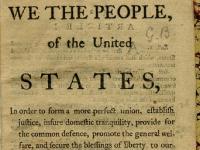This lesson is intended to set the stage for student analysis of the U.S. Constitution. To understand how the Constitution establishes the framework for government, students need to be introduced to the principles the framers used to guide them when considering different governmental functions. In this introduction, the students will define the seven basic principles of the Constitution.
The Seven Principles of the Constitution
The Seven Principles of the Constitution
Essential Questions
Objectives
Students will be able to:
- Identify the seven principles of the U.S. Constitution
- Express the vocabulary meaning in both a written and graphic context
- Contextualize the Constitution within the framework of the seven principles
Suggested Instructional Procedures
1. Begin with a brief overview of how the United States government is constructed; i.e. three branches of government and what those branches do. This brief overview should be based on general questions that can be answered by individual students in order to activate prior knowledge.
2. Handout “seven principles” worksheet and explain to the students they will be learning about the seven most important principles the framers used to write the Consitution.
a. As you go through the definitions on the powerpoint, the students will need to copy them down in the correct box on their worksheet.
b. Ask the students, “Can anybody give me any examples of this principle?” – Example: Checks and Balances = president's ability to veto.
c. After the definition is copied, you will give the students a few minutes to draw a picture that represents the definition in the appropriate box on their worksheet.
d. After the students have created their picture, ask for two or three examples (students will describe what they have created).
3. Once the powerpoint with the definitions and images are complete, ask the students;
a. “Can anyone name examples of any of these principles they have experienced, seen on the news, or have experienced lately?”
b. “Can anybody give me examples from the US Constitution of any of these principles?”
4. Exit Ticket: Have students put the worksheet in their bag, handout exist tickets, and tell them:
a. Write down your favorite principle ( the list is on the last powerpoint slide), what that principle means, and why it is your favourite?
Vocabulary
- Popular Sovereignty: People Control the government
- Republicanism: A political philosophy that advocates for people electing their own legislatures to represent them government
- Limited Government: The government only has the power provided to by the Constitution
- Federalism: Separation of governmental power between state and national government
- Separation of Powe: The separation of political power into three independent branches of government
- Checks and Balances: Different branches of government are empowered to balance the power of the other branches to ensure that no one branch consolidates too much power
- Individual Rights: Rights guaranteed by the Constitution to citizens
Related Resources for Students
Files

Plans in this Unit
Grade Level
Duration
Standards/Eligible Content
About the Author
This lesson was created by Brendon Floyd, Education Intern at the Historical Society of Pennsylvania
Attention Teachers!
Let us know how you used this plan and be featured on our site! Submit your story here.

